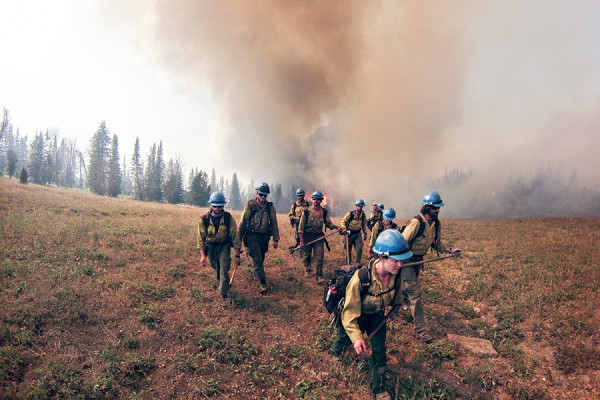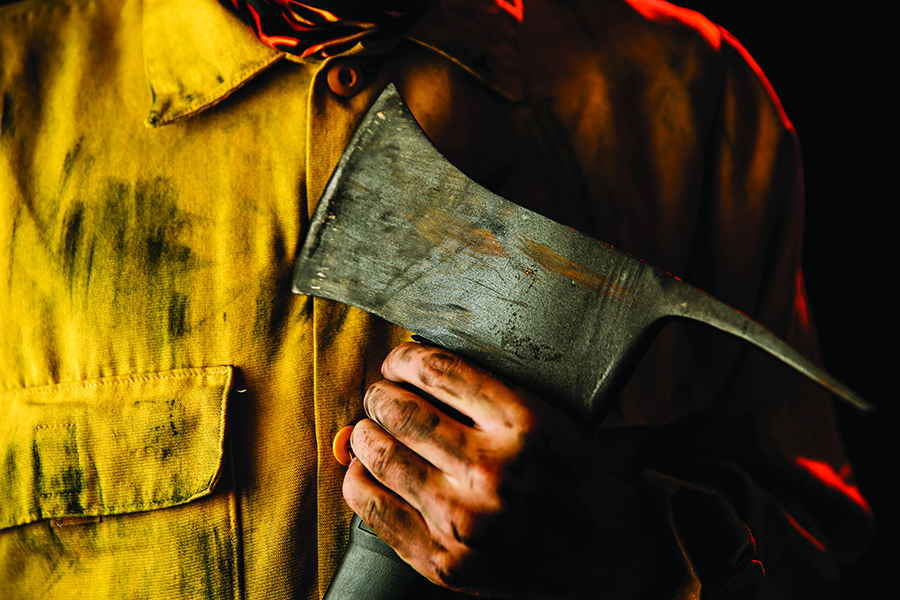Wearing a patina of dirt, sweat and chainsaw oil accumulated over six long days entrenched in the Rocky Mountains at the height of summer, the elite group of wilderness firefighters from Hungry Horse was preparing to press deeper into the smoke-obscured forest when an invisible enemy crept within the ranks. For nearly a week, the 20 men and women had been working to corral a 12-acre wildfire burning in thick timber and steep terrain on Elevation Mountain, near Clearwater Junction, and they were inching closer toward buttoning up the blaze when the silent intruder emerged.
Someone caught a cold.
Or at least, it felt like a cold. During a normal wildfire season, the catalog of cold-like symptoms — scratchy throat, runny nose, persistent cough — represent occupational hazards so ubiquitous and mundane that most members of a hotshot crew wouldn’t bother to mention them on a fireline. There’s even a generic name for the cocktail of maladies, which spread easily through high-density encampments of wildland firefighters each season — “camp crud.”
But this is not a normal wildfire season, and this wasn’t an ordinary cold.
In the age of COVID-19, the presentation of cold- or flu-like symptoms by a wildland firefighter triggers a sequence of events that can lead to the demobilization of an entire unit assigned to a wildfire, derailing precious resources that are stretched increasingly thin as the 2020 season intensifies.
“In a typical fire season, there is your basic funk going around, and because you’re working in an environment of dust and smoke, when someone develops a cough or a runny nose, that is pretty common,” Shawn Borgen, superintendent of the Flathead Interagency Hotshot Crew, said. “You don’t just shut everything down. You probably don’t even take the day off work. But COVID-19 has changed everything. Unless everyone gets tested, we don’t know if that cough or that runny nose is going to take out an entire division. We’re living in the presence of an invisible enemy, and how do you manage tracking an invisible enemy? It’s like fighting a ghost.”
For the Flathead Hotshots, one of the nation’s oldest and most esteemed elite firefighting units, as well as the tens of thousands of firefighters mobilized across the country, tracking the invisible enemy has required heightened vigilance and adaptability, as well as a high degree of individual trust, both on and off the fireline.
This year, Borgen and his crew have been adhering to a new set of guidelines and safety protocol tailored to firefighters working to navigate the complexities of the pandemic in a wildland fire environment. They include the “Infectious Disease Guidelines for Wildland Fire Incident Management Teams” plan developed by the National Wildfire Coordinating Group’s Emergency Medical Committee, which is at the vanguard of developing policies to prevent the spread of COVID-19 through fire camps, based largely on Centers for Disease Control and Prevention (CDC) recommendations.
LISTEN: Reporter Tristan Scott shares more insight from this story on this week’s episode of the Flathead Beacon podcast. Subscribe wherever you get your podcasts.

The guidelines include recommendations that firefighters maintain social distancing, wear face coverings and reduce the density of fire camps while regularly sanitizing and disinfecting shared spaces, like the insides of vehicles and meeting areas. But perhaps the most important measure describes how each crew should employ a “Module as One” isolation concept, wherein crews and units limit close contact with other resources, operating as a closed circuit that provides “insulation to these crews so they can function as a family unit.”
“This is the same concept families have used to limit exposure to the COVID-19 virus,” according to Kaari Carpenter, a national spokesperson for the U.S. Forest Service. “We are encouraging our crews to manage themselves more like families than individuals. It is effective in limiting exposure to non-module members, and if an outbreak occurs within the module, it can be contained to a limited number of people, versus transmitting to other crews or individuals.”
For a hotshot crew, operating as a family unit comes naturally. In military parlance, hotshots are the elite “special forces” of the wildland firefighting world, and in the modern era of violent wildfires burning larger and more often than at anytime in the nation’s history, there’s no shortage of demand for their services.
So far this year, the Flathead National Forest has responded to more than three-dozen wildfires, dispatching crews to battle blazes across Montana as well as in Colorado, Wyoming, Oregon, California, Nevada, Arizona, and New Mexico. During the period known as “fire season,” which can stretch five to six months, the Flathead Hotshots live and work side-by-side for two-week stretches at a time, attacking volatile sections of large fires in 16-hour shifts, laboring under punishing conditions and in sweltering heat, while eating and sleeping in tight quarters.
While such conditions might render the conventions of “social distancing” moot, they allow the module as one concept to function both practically and effectively. Indeed, the highest degree of vulnerability comes when crew members re-enter civilian life and mingle with a greater variety of pathways, which are limited on the fireline.
“You look at your crew like you would your family, and once you’re assembled you manage the unit as such,” Borgen said. “The challenge then becomes how folks conduct themselves in their personal lives, around their actual families, after the shift ends and they go home to their other module of one. Right now, that’s when we have the highest risk of exposure. When we’re together on a fire operation, we’re incredibly disciplined. We stay together. It’s when we go home and have to go to the gas station that we increase the risk of exposure. And that’s what happened to us two weeks ago.”
Screening protocol for wildland fire personnel requires that every crew member tick through a self-assessment before reporting to work, and as the Flathead Hotshots were wrapping up their hitch on the Elevation Mountain fire last month one of the firefighters reported not feeling well.
The person was isolated and tested for COVID-19, and when the results came back positive for the virus the entire module was pulled from the operation and placed in quarantine awaiting test results. Out of the 20-member crew, three individuals tested positive for COVID-19; however, the entire crew was demobilized and forced to quarantine for 14 days to account for the high rate of “false negatives.”
In the case of the Elevation Mountain fire, numerous other fire personnel were tested, including another hotshot crew as well as smokejumpers, all of them siloed in their respective modules.
“They all tested negative, which further goes to show that the module as one concept is effective,” Borgen said. “There were 60 people on that fire for six days and we only had three positives. And we managed to put that fire out. It could easily have been 60 positives, and the fire’s still burning.”
But even three positive cases in a module consisting of 20 wildland firefighters is significant, particularly when it takes the entire unit off line.
According to a July 2 memo from U.S. Forest Service Chief Victoria Christiansen, a 14-day quarantine is mandated for employees awaiting required test results or who test positive as a result of a mission assignment. The employee should attempt to self-isolate at their residence, which often isn’t feasible without exposing others in the home. In those instances, the Forest Service must offer and pay for alternative housing or an alternative work location for up to 14 days.
The COVID-19 prevention measures developed for wildland firefighters also describe a worst-case scenario in which multiple outbreaks combine to stymie the nation’s ability to respond as wildfire season peaks, and new research affirms the potential for this concern to be fully realized.

A study published last month by researchers at Colorado State University and the U.S. Forest Service’s Rocky Mountain Research Station concluded that COVID outbreaks “could be a serious threat to the firefighting mission” and urged vigilant social distancing and screening measures in the camps.
“If simultaneous fires incurred outbreaks, the entire wildland response system could be stressed substantially, with a large portion of the workforce quarantined,” the study’s authors wrote.
The reality of social distancing in a wildland firefighting environment is often impractical, Borgen said, as are recommendations that firefighters wear masks and face coverings. The module as one concept appears to be working, however, even if it places a high level of trust in the individual firefighters to report symptoms and illnesses.
Another factor that is critical and often overlooked in the risk-mitigation calculus surrounding wildland firefighting during a pandemic is the responsibility of the general public, whose reckless behavior leads to unnecessary human-caused fires.
For example, so far this year, of the 36 fires that have required resources from the Flathead National Forest, 19 have been human-caused, averaging about three acres, according to Flathead National Forest spokesperson Lauren Alley. Even if those fires are quickly suppressed, they still sap badly needed resources for at least a day.
According to Borgen, the amount of resources dedicated to unattended campfires has been unprecedented this summer, as more people from out of state flock to the region for its outdoor amenities.
“Every day we are averaging at least two initial attacks, sometimes upward of six, between state resources and the Forest Service in the Flathead Valley,” Borgen said. “Every single day. And most of those are human-caused starts.”
“You can drive up any forest road and see out-of-state license plates and people camping, and because we’re not in fire restrictions they all want to have their s’mores and their hot dogs around a campfire, which is fine, but it’s not fine when that campfire isn’t put out,” he added. “There have been more examples of that kind of reckless behavior this summer than I have seen in 25 years.”
On Aug. 31, Borgen was just one day removed from his own quarantine while he prepared to head to California to help battle the wildfires devastating the state, which is commanding a majority of the 28,000 interagency firefighters deployed across the country to fight fire, particularly as partner agencies are maxed out to capacity. More than 6,000 of those firefighters are with the U.S. Forest Service, which is supplemented by about 200 U.S. Army soldiers as the federal government reaches out to international partners in Australia and Canada for support.
As fire season continues in full swing, Borgen said the task of fighting wildfire amid the concerns of a global pandemic adds a greater degree of uncertainty to an already unpredictable business.
“It’s really hard to write a complete playbook to deal with all of the scenarios that keep popping up,” Borgen said. “And it’s tough because our lives are at risk, both on the front lines of a fire and on the front lines of a pandemic.
He continued: “Yeah, we’re operating as a module of one, but our module is made up of individual lives. When these things happen, you can’t make decisions based on a module alone. You have to make determinations based on each person’s unique life. It’s no longer looking at the Flathead Hotshots as one asset, you’re looking at the Flathead Hotshots as 20 individual lives, and we all share in the responsibility for protecting them.”
